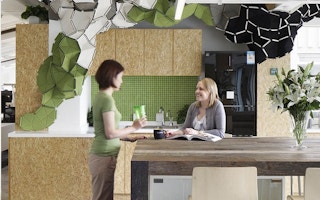Green buildings are better for the planet, but a growing movement of healthy workplaces shows they can be good for people too.
Responding to new research that shows the multiple impacts that the built and indoor environment have on human health, developers are increasingly moving beyond energy efficiency to promote the health and well-being of people who live, work and play there.
Besides reducing the built environment’s carbon footprint by minimising water, waste and energy consumption, green design features and amenities are being integrated into office spaces to improve the health and productivity of employees and other building occupants.
“There’s a lot of evidence on how buildings have an impact on human life, even though the focus has more often been on their environmental footprint. What we are now seeing is how healthy buildings, which are both sustainable and beneficial for people, can make workers more productive and less likely to get sick,” said Scott Dunn, vice-president of engineering firm AECOM at this year’s International Built Environment Week, organised by Singapore’s Building and Construction Authority.
“There’s been an uptake in places such as care and medical centres in many of our cities, but it’s not necessarily the right or only way to approach what we could be doing for overall society, which is to influence better health in the built environment.” said Dunn.
He added that while the relationship between the indoor environment and human health has been explored in studies on the sick building syndrome, which links human illnesses to unhealthy conditions indoors, developers today have to do more than “getting rid of the bad stuff” in their spaces.
They can introduce elements that can improve occupants’ health and well-being, such as biophilic features (which foster closer connections between people and the natural environment), better indoor air quality and ventilation, natural lighting and active design elements that make physical activity and healthy food more appealing to people.
Is there a business case for healthy buildings?
According to Dunn, developers that have sought building certifications such as the Well Building Standard or the Fitwel Standard, which support healthier workplace environments, were convinced that investments to improve occupant health will pay off in the long run.
“The market trends show a renewed emphasis on healthy lifestyles, fitness, nutrition and people being more conscious about their living and eating habits in general. The business case now starts with a combination of consumer focus on wellness and the need to make workplaces more attractive,” he said.
Healthier and more conducive work environments help increase tenant productivity and employee satisfaction, according to recent studies.
In a 2017 survey by non-profit corporate real estate association CoreNet Global and CBRE, an American commercial real estate services and investment firm, 47 per cent of senior executives across real estate, tech and finance companies reported increased employee engagement and 25 per cent reported a rise in employee retention when they improved their workplace health and wellness design.
According to Dunn, more employers are now willing to pay a premium for offices that boost recruitment, productivity and retention.
Making space in the city for human well-being
“As humans, we have an innate link to nature and as the world becomes more urbanised, we will grow even more drawn to it. An abundance of greenery and biophilic elements that mimic nature in the workplace reduces stress and enhances the human experience,” said Angela Spathonis, studio director at Gensler, a global design and architecture firm based in the United States.
Speaking on a panel about “Improving liveability through greener and healthier spaces,” Spathonis added that biophilic features in the workplace go a long way in reducing employee turnover and increasing productivity, which generates economic benefits ranging from US$1,000 per employee to US$3.6 million company-wide.
Spathonis’ company is behind engineering firm Glumac’s carbon-neutral office in Shanghai in China. The 6,000 square-foot office, the first to apply for the rigorous Living Building Challenge project certification in Asia, is equipped with an indoor air monitoring system that allows occupants to check the level of toxicity in the indoor air on their mobile phones. A green wall also helps to filter any pollution coming in from the outdoor downtown area.
Urban planners in Asia are also incorporating greener and healthier spaces into the built environment by designing outdoor areas to increase people’s mental well-being and relieve stress.
“City living is often stressful and urban development has a significant impact on public health,” said M Pungkothai, director of the Community-in-Bloom and Skyrise Greenery programme at Singapore’s National Parks Board, which introduced therapeutic gardens at several parks across the country.
Therapeutic gardens provide respite for city dwellers and meet the physical, psychological and social needs of those who visit the park, especially the elderly, she said.
“With dense urbanisation and increased reliance on digital technology, creating more space for natural elements or increasing access to parks and gardens can help in making those living in a city happier and healthier.”













